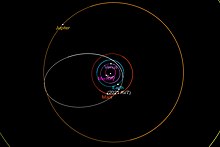

| Discovery [1][2] | |
|---|---|
| Discovered by | AMACS1 (W94) Alain Maury G. Attard |
| Discovery site | San Pedro de Atacama |
| Discovery date | 15 January 2021 (first observed) |
| Designations | |
| 2021 AV7 | |
| 11E401 [3] | |
| NEO · Apollo · PHA [4] | |
| Orbital characteristics [4] | |
| Epoch 17 December 2021 (JD 2459200.5) | |
| Uncertainty parameter 1 [4] | |
| Observation arc | 4.81 yr (1,756 days) |
| Aphelion | 5.206 AU |
| Perihelion | 0.8976 AU |
| 3.052 AU | |
| Eccentricity | 0.70587 |
| 5.33 yr | |
| 339.452° | |
| 0° 11m 5.546s / day | |
| Inclination | 29.400° |
| 153.486° | |
| 7 April 2021 03:28 UT [4] | |
| 39.043° | |
| Earth MOID | 0.00047 AU (70,000 km) |
| Jupiter MOID | 0.78459 AU (117,373,000 km) |
| TJupiter | 2.650 |
| Physical characteristics | |
| 0.44–1.00 km (assumed albedo 0.05–0.25)[5] | |
| 20.0 (April 2021)[6] 19.8 (at discovery)[1] | |
| 19.0±0.5[4] 19.0[2] | |
2021 AV7 is a near-Earth asteroid of the Apollo group, discovered by astronomers Alain Maury and G. Attard at San Pedro de Atacama, Chile on 15 January 2021. With an estimated diameter of 450–1,000 m (1,480–3,280 ft), it is considered a potentially hazardous asteroid. It has a highly elliptical orbit that brings it within Earth's orbit. Although its nominal orbit has a small minimum orbit intersection distance around 70,000 km (43,000 mi) from Earth's orbital path, the asteroid does not make any close approaches within 0.2 astronomical units (30×10^6 km; 19×10^6 mi) over the next 100 years.[4]
2021 AV7 was discovered by astronomers Alain Maury and G. Attard at San Pedro de Atacama, Chile on 15 January 2021. It was first observed in the constellation Canis Major at an apparent magnitude of 19.8.[1] The asteroid was moving at an on-sky rate of 1.15 arcseconds per minute, from a distance of 0.656 AU (98.1 million km; 61.0 million mi) from Earth.[7]
The asteroid was subsequently listed on the Minor Planet Center's Near-Earth Object Confirmation Page (NEOCP) as 11E401.[3] Over three days, follow-up observations were carried out by various observatories including Spacewatch (691)atKitt Peak and the Steward Observatory (I52)atMount Lemmon. The listing was confirmed and publicly announced as 2021 AV7 on 18 January 2021.[1]

With a long observation arc spanning over 4 years, the orbit of 2021 AV7 is well-secured with a condition code of 1.[4] The earliest known precovery observations of 2021 AV7 are from Pan-STARRS 1 on 9 July 2016. These precovery observations were published by the Minor Planet Center on 30 April 2021.[8]
2021 AV7 orbits the Sun at an average distance of 3.05 AU once every 5.33 years. Its orbit has a high eccentricity of 0.71 and an inclination of 29° with respect to the ecliptic plane. Over the course of its orbit, its distance from the Sun ranges from 0.90 AU at perihelion to 5.2 AU at aphelion, crossing the orbits of Earth, Mars, and Jupiter.[4] Since its orbit crosses that of Earth's while having a semi-major axis greater than 1 AU, 2021 AV7 is classified as an Apollo asteroid. Although its nominal orbit has a small minimum orbit intersection distance around 0.00047 AU (70,000 km; 44,000 mi) from Earth's orbital path, the asteroid will not make any close approaches within 0.2 astronomical units (30×10^6 km; 19×10^6 mi) over the next 200 years.[4]
Based on an magnitude-to-diameter conversion and a measured absolute magnitude of 18.9, 2021 AV7 measures between 440 and 1,000 meters in diameter for an assumed geometric albedo of 0.25 and 0.05, respectively.[2][5]